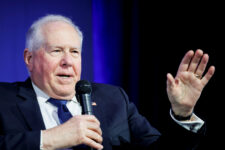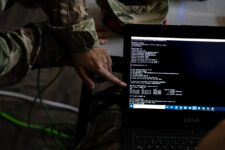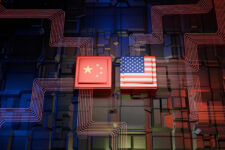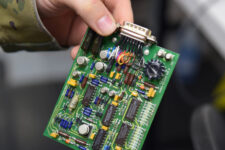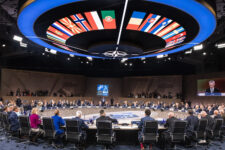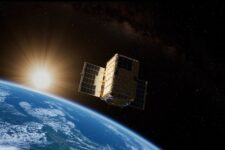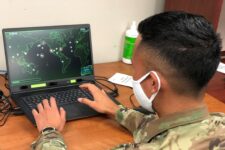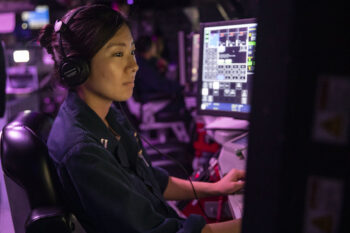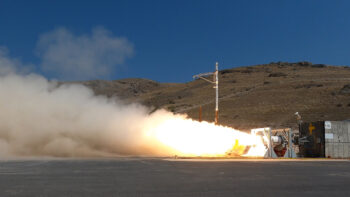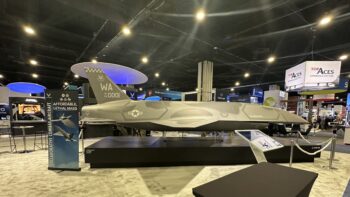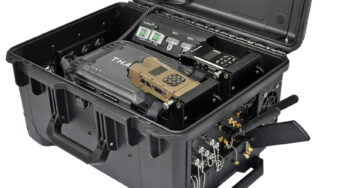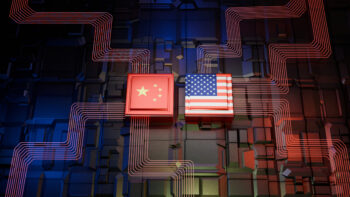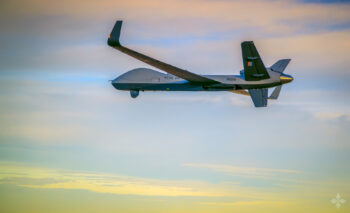
On-orbit render of the Q4S satellite which promises to unlock understanding of how quantum entanglement swapping behaves on orbit. (Boeing image)
WASHINGTON — After years of refining the technology in the lab, Boeing plans to launch a novel quantum communications technology into space. It’s the latest step in the global race to harness mind-bending physics that Einstein once derided as “spooky action at a distance.”
Called Q4S because it relies on creating quantum entanglement between four photons, the Boeing approach goes beyond Chinese and European experiments in so-called Quantum Key Distribution (QKD) — a technique the NSA and NIST have called impractical — and could connect widely separated quantum sensors for ultra-precise long-baseline measurements, said the project’s chief engineer.
“We are not doing something that the government is skeptical of,” said Jay Lowell, Boeing’s chief engineer for Disruptive Computing, Networks, & Sensors, in a pre-release call for reporters ahead of the formal rollout, timed for Lowell’s presentation to Quantum World Congress in DC. “We are in fact looking beyond QKD to [a] more generalized communication protocol that would be needed to support a wider variety of quantum applications over a network.”
Quantum Key Distribution, as its name implies, uses pairs of entangled particles to share cryptographic keys securely over vast distances, keys which recipients can then use to encode subsequent communications over conventional, non-quantum channels. Only the keys themselves are transmitted using quantum phenomena.
By contrast, Boeing’s Q4S approach uses two pairs of entangled particles (specifically particles of light, photons) to establish a near-perfect correlation between distant locations. If something happens to one particle in an entangled pair, the other particle in the pair will change to reflect that within “a couple of hundred femtoseconds,” Lowell said. There are a million billion femtoseconds in a second, so that’s effectively instantaneous for all practical purposes.
(It is not, however, perfectly instantaneous or faster than light, Lowell emphasized: “We’re not trying to break causality.”)
Why does this kind of correlation matter? Think back to the scenes in old war movies or crime capers where the heroes make sure their watches are all set to the exact same time, allowing them to coordinate their actions. Now imagine being able to “synchronize your watches” with people who aren’t next to each other but thousands of miles apart, with an accuracy not to the minute or even the second but to a fraction of a billionth of a second.
One application, Lowell said, is precision timing, a crucial concern for military networks and targeting systems, where tiny errors in coordination can result in encrypted communications breaking down or missiles flying off course.
But Q4S could also allow widely separated sensors — perhaps radars, perhaps near-future quantum sensors — to compare measurements with effectively perfect precision, Lowell said. Such a high-precision link allows the separated sensors to act, in effect, with the power of a single giant sensor, what’s known as a very large baseline array.
Finally, Lowell suggested, Q4S could be used to create a network among widely separated quantum computers, allowing them to exchange quantum information directly.
“We’re pushing the boundaries of what is being done in the quantum networking space,” he told reporters. “In essence, this is the generalized communication protocol that’s needed for a quantum network that’s not just sending a stream of single photons, [but] a global quantum network connecting quantum sensors, quantum computers.”
This vision will take a while to realize, Lowell admitted: “It’s early days,” he said. Boeing has successfully tested their Q4S entanglement on the ground, in the lab, but to communicate efficiently and effectively over long distances, they need it to work in space, on a communications satellite. So they’re currently hardening the equipment against vacuum, radiation, the sheer physical shock of rocket launch, and all the other hazards of space.
Then, next year, they’ll launch their Q4S experiment on an Astro Digital Corvus satellite. No, not a Boeing one, Lowell acknowledged. “I’ve gotten a hard time about that” from colleagues, he told reporters, but Astro Digital demonstrated the ability to provide the necessary power in a compact package.
Even assuming the 2026 launch succeeds, Boeing will need to crunch the data and conduct “probably more than one” additional experiments before the tech is ready for real-world use, Lowell said. But, he went on, “we’re pretty confident this is not a question of if this happens, but when.”
CCA drones may not be tied to NGAD, need line-of-sight control: Kendall
The Air Force Secretary emphasized whatever plane flies with CCAs, it’ll be manned and will need line-of-sight to maintain “tight control.”
